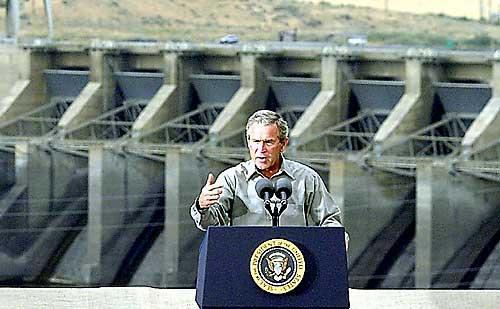forum
library
tutorial
contact

Shred the Roadmap to Salmon Extinction
by Bruce BabbittLos Angeles Times, December 30, 2004
|
the film forum library tutorial contact |

|
Shred the Roadmap to Salmon Extinctionby Bruce BabbittLos Angeles Times, December 30, 2004 |
 Wild salmon are drifting toward extinction in the northern Rocky Mountains. Last month, the Bush administration delivered a decision that will be the death blow, if it stands: four obsolete dams on the Snake River in eastern Washington state will not be dismantled.
Wild salmon are drifting toward extinction in the northern Rocky Mountains. Last month, the Bush administration delivered a decision that will be the death blow, if it stands: four obsolete dams on the Snake River in eastern Washington state will not be dismantled.
The Snake River dams were conceived on a field of industrial dreams. The idea took root in the 1960s, when local boosters persuaded Congress to authorize a huge project to transform Lewiston, Idaho, 400 miles from the Pacific, into a seaport.
The Army Corps of Engineers then proceeded to subdue 140 miles of the wild Snake, remaking it into a slack-water barge channel.
The dream soon turned into a nightmare for people and towns that depend on wild salmon. The fish began disappearing from the lakes and rivers upstream from the dams.
In one year, only a single sockeye managed to find its way up to Redfish Lake, in the Sawtooth Mountains, to spawn.
Prized Chinook runs vanished throughout central Idaho. Fisheries and fishing jobs in the Northwest and as far away as Alaska, tribal fisheries included, declined with them.
Meanwhile, the promised inland seaport boom did not arrive.
The volume of barge shipments never reached expectations, in part because many farmers in the region still found it cheaper to ship by rail to the deep-water port at Tacoma.
That didn't deter the corps, which continues to spend $36 million a year to operate and maintain the four Snake River dams, their locks and the navigation channel.
Yet even at this late date, there is still a chance to save the salmon. The corps, the farmers and the fishermen could cooperate to get the wheat off the river and onto railroads where it belongs.
The track is in place. The mainlines of the Burlington Northern and the Union Pacific run right through this wheat country and then west to ports at Pasco, Vancouver, Tacoma and Portland.
The state of Washington just purchased the short lines that feed the mainlines. This system already ships a lot of local wheat, and with modest further investment, the Burlington Northern says it will be ready and willing to handle what is now shipped by river.
Farmers near the river who use the channel to transport grain are the main voice for keeping the dams, because they save 3 to 7 cents per bushel compared with shipping by rail. What stands between waters alive with salmon and the silent expanses of extinction is that 3 to 7 cents per bushel.
All of this cries out for a common-sense solution that takes all sides into account. There is one that has yet to be considered: Simply shut down the barge traffic, take out the dams and then dedicate a small part of the annual $36 million that would be saved to making up the shipping differential with the farmers.
In contrast, the administration's plan to keep the dams and "save" the salmon has an estimated total cost of $6 billion over the next 10 years. Much of that would go to various schemes to barge, truck, pipe and steer migrating salmon around the dams.
Scientists have repeatedly concluded that these proposals offer little hope of restoring the wild salmon to fishable abundance.
Neither science nor logic — nor economic theory — supports the administration's plan. The dams could be dismantled, the farmers who ship on the river compensated and the relatively small amount of electricity the dams generate replaced, for about one-third of the $6 billion. A restored fishery would be worth at least $1 billion a year to Pacific Northwest states.
The administration's plan is a very expensive roadmap to salmon extinction. It's time to admit a mistake and set about fixing it for the sake of fishermen, farmers, Native Americans, the salmon, the inland Pacific Northwest ecosystem — and the taxpayers.
learn more on topics covered in the film
see the video
read the script
learn the songs
discussion forum
